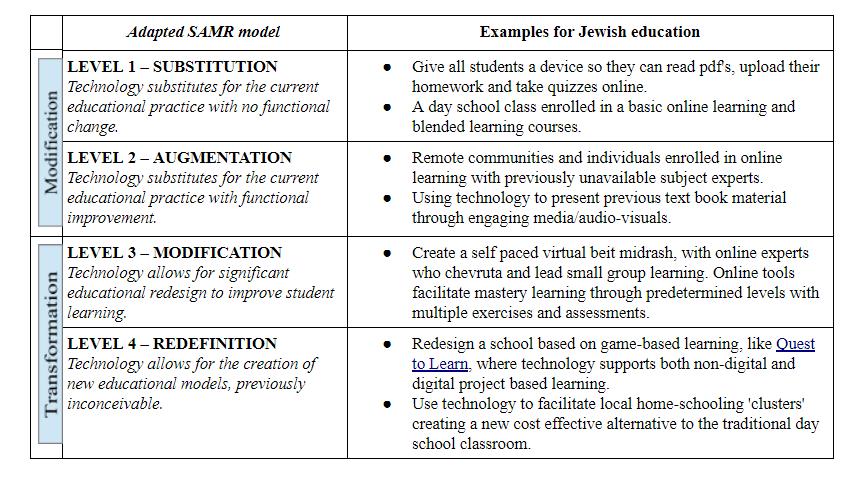It’s Time for Tech Talk 2.0
Reuven Margrett works at the Pardes Center for Jewish Educators and is an experienced day school educator and administrator who ran a paperless iPad classroom for several years. Passionate about enhancing student learning he created the first serious Jewish text learning games, Sparks of Eternity, and Kerem b'Yavneh. Reuven led technology-focused professional development and presented at national conferences and webinars about digital gaming, technology, and tefilah.
Just over a year ago with the release of the William Davidson Foundation & Jim Joseph Foundation SmartMoney technology report, there was renewed interest within the Jewish community about how technology could enhance student learning. Further ideas were voiced through eJewish Philanthropy's Continuing Conversations On Leveraging Educational Technology. This article aims to enhance the conversation by suggesting a shared language and theoretical framework for moving Jewish ed tech from important yet disparate conversations to a more cohesive systematic goal focused dialogue.
In 2013 Dr. Ruben Puentedura, through his own extensive experience and research, developed a framework of different levels of use of technology use in the classroom. It is called the SAMR model and can be summarized and illustrated as follows:
LEVEL 1 - SUBSTITUTION - Technology acts as a substitute with no functional change.
E.g. Rather than getting students to fill out a Talmud worksheet with pen and paper, they fill out a PDF of that worksheet on their device.
LEVEL 2 – AUGMENTATION - Technology acts as a direct tool substitute with functional improvement.
E.g. With that PDF worksheet, using Notability on the iPad (or other tools on other devices), students can easily highlight, add punctuation, erase, move text boxes around, and send chevruta work to the teacher.
LEVEL 3 – MODIFICATION - Technology allows for significant task redesign.
E.g. students will annotate a daf of Gemara (e.g. using Slingnote) with researched pictorial references/descriptions to items and places mentioned in the sugya (tanur – Mishnaic oven, dinar – a type of currency, rechayim – millstone). Students will then view and comment on others students commentaries incorporating new information into their own commentary.
LEVEL 4 – REDEFINITION - Technology allows for the creation of new tasks, previously inconceivable.
Class (A) will pair with another class (B) in another school. Students (A) will teach the sugya to other students in this other class (B), asynchronously using Nearpod to present information, create assessments, receive questions, and post comments. The other class (B) will reciprocate and teach a different sugya to this class (A).
Levels 1 and 2 are considered enhancements of pedagogy, whereas levels three and four are called transformations. Teachers (and organizations) may initially be more comfortable with technological enhancements before exploring technological transformation.
This model provides a common language for foundations, Jewish edtech providers, organizations, and teachers to frame their conversations. Do they want to focus on level 1 and 2 enhancements in order to make teaching more accessible and efficient, or transform the educational experience focussing on levels 3 and 4 to bring more creativity, collaboration, and critical thinking?
When framed this way conversations, ideas, and current products can be seen in an overall structure. Some current Jewish edtech providers are firmly situated at the level of modification, whereas others are venturing into transformation.
If we take this idea and 'level it up' we can further refine the conversations about the future directions of Jewish edtech. By using the SAMR model, with slight amendments to the definitions, the focus shifts from using this app, or that tool, to the overall use and impact that technology has on the efficiency, availability, impact, and quality of Jewish learning. Below is a modified SAMR model with my own made up examples/ideas relevant to the Jewish community. Where would you place your own ideas on this table?

It is time we take ownership of the sometimes overwhelming and blanket conversations about technology, clarify what the goals are (augmentation, modification etc.), and have serious conversations about what is, and what needs to be.
Rabbi Jonathan Sacks likens the current technological revolution to that of the printing press that had far reaching consequences. Within the Jewish educational context there is the potential for tremendous modifications and transformations in educational outcomes, pedagogical innovation, and new financial models for sustainability. Our challenge is to harness technological power for good, and the first step is having an appropriate language and framework, so our community can engage in a shared, thoughtful and forward thinking conversation.
